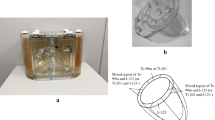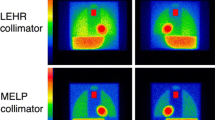Abstract
Background
Septal penetration of high-energy photons may degrade the quality of single photon emission computed tomography (SPECT) of the heart with iodine 123-labeled tracers. We investigated the impact of collimator choice on cardiac SPECT with I-123.
Methods and Results
SPECT of a thoracic phantom containing I-123 solution was performed with a low-energy high-resolution (LEHR) collimator, special LEHR (SLEHR) collimator, and medium-energy (ME) collimator, and the cavity-to-myocardium contrast, wall thickness, and defect contrast were compared among the collimators. For all indices, use of the SLEHR collimator yielded the best results. Comparison between the LEHR and ME collimators revealed that the cavity-to-myocardium contrast and contrast for large defects were better with the ME collimator, whereas wall thickness and contrast for small defects were similar. Scatter correction by the triple-energy window method improved the indices examined; however, the superiority of the SLEHR collimator was still observed after correction.
Conclusions
Collimator choice substantially influences the quality of cardiac SPECT with I-123-labeled agents, and an appropriate collimator needs to be selected in consideration of septal penetration and spatial resolution.
Similar content being viewed by others
References
Dobbeleir AA, Hambye AS, Franken PR. Influence of high-energy photons on the spectrum of iodine-123 with low- and mediumenergy collimators: consequences for imaging with 123I-labelled compounds in clinical practice. Eur J Nucl Med 1999;26:655–8.
Macey DJ, DeNardo GL, DeNardo SJ, Hines HH. Comparison of low- and medium-energy collimators for SPECT imaging with iodine-123-labeled antibodies. J Nucl Med 1986;27:1467–74.
De Geeter FD, Franken PR, Defrise M, et al. Optimal collimator choice for sequential iodine-123 and technetium-99m imaging. Eur J Nucl Med 1996;23:768–74.
Fleming JS, Alaamer AS. Influence of collimator characteristics on quantification in SPECT. J Nucl Med 1996;37:1832–6.
Dobbeleir AA, Hambye ASE, Franken PR. Influence of methodology on the presence and extent of mismatching between 99mTc- MIBI and 123I-BMIPP in myocardial viability studies. J Nucl Med 1999;40:707–14.
Bolmsjo MS, Persson BR, Strand SE. Imaging 123I with a scintillation camera. A study of detection performance and quality factor concepts. Phys Med Biol 1977;22:266–77.
Patel AD, Iskandrian AE. MIBG imaging. J Nucl Cardiol 2002;9:75–944.
Hattori N, Schwaiger M. Metaiodobenzylguanidine scintigraphy of the heart: what have we learnt clinically? Eur J Nucl Med 2000;27:1–6.
Inoue Y, Suzuki A, Shirouzu I, et al. Effect of collimator choice on quantitative assessment of cardiac iodine 123 MIBG uptake. J Nucl Cardiol 2003;10:623–32.
Ichihara T, Ogawa K, Motomura N, Kubo A, Hashimoto S.. Compton scatter compensation using the triple-energy window method for single- and dual-isotope SPECT. J Nucl Med 1993;34:2216–211.
Inoue Y, Shirouzu I, Machida T, et al..Physical characteristics of low and medium energy collimators for 123I imaging and simultaneous dual-isotope imaging. Nucl Med Commun 2003;24:1195–202.
Gilland DR, Jaszczak RJ, Turkington TG, Greer KL, Coleman RE. Volume and activity quantitation with iodine-123 SPECT. J Nucl Med 1994;35:1707–13.
Ogasawara K, Hashimoto J, Ogawa K, et al. Simultaneous acquisition of iodine-123 emission and technetium-99m transmission data for quantitative brain single-photon emission tomographic imaging. Eur J Nucl Med 1998;25:1537–44.
Nohara R. Lipid metabolism in the heart-contribution of BMIPP to the diseased heart. Ann Nucl Med 2001;15:403–9.
Buvat I, Benali H, Todd-Pokropek A, Di Paola R. Scatter correction in scintigraphy: the state of art. Eur J Nucl Med 1994;21:675–94.
Tsui BM, Frey EC, LaCroix KJ, et al. Quantitative myocardial perfusion SPECT. J Nucl Cardiol 1998;5:507–22.
Iida H, Narita Y, Kado H, et al. Effects of scatter and attenuation correction on quantitative assessment of regional cerebral blood flow with SPECT. J Nucl Med 1998;39:181–9.
Hashimoto J, Sasaki T, Ogawa K, et al. Effects of scatter and attenuation correction on quantitative analysis of -CIT brain SPET. Nucl Med Commun 1999;20:159–65.
Saito K, Takeda K, Okamoto S, et al. Detection of doxorubicin cardiotoxicity by using iodine-123 BMIPP early dynamic SPECT: quantitative evaluation of early abnormality of fatty acid metabolism with the Rutland method. J Nucl Cardiol 2000;7:553–61.
Kim Y, Sawada Y, Fujiwara G, Chiba H, Nishimura T. Therapeutic effect of co-enzyme Q10 on idiopathic dilated cardiomyopathy: assessment by iodine-123 labelled 15-(p-iodophenyl)-3(R,S)- methylpentadecanoic acid myocardial single-photon emission tomography. Eur J Nucl Med 1997;24:629–34.
Takeda K, Saito K, Makino K, et al. Iodine-123-BMIPP myocardial washout and cardiac work during exercise in normal and ischemic hearts. J Nucl Med 1997;38:559–63.
Yang JT, Yamamoto K, Sadato N, et al. Clinical value of triple-energy window scatter correction in simultaneous dualisotope single-photon emission tomography with 123I-BMIPP and 201Tl. Eur J Nucl Med 1997;24:1099–106.
Narita Y, Iida H, Eberl S, Nakamura T. Monte Carlo evaluation of accuracy and noise properties of two scatter correction methods for 201Tl cardiac SPECT. IEEE Trans Nucl Sci 1997;44:2465–72.
Narita Y, Iida H. Scatter correction in myocardial thallium SPECT: needs for optimization of energy window settings in the energy window-based scatter correction techniques [in Japanese]. Kaku Igaku 1999;36:83–90.
Author information
Authors and Affiliations
Corresponding author
Rights and permissions
About this article
Cite this article
Inoue, Y., Shirouzu, I., Machida, T. et al. Collimator choice in cardiac SPECT with I-123-labeled tracers. J Nucl Cardiol 11, 433–439 (2004). https://doi.org/10.1016/j.nuclcard.2004.04.009
Received:
Accepted:
Issue Date:
DOI: https://doi.org/10.1016/j.nuclcard.2004.04.009




